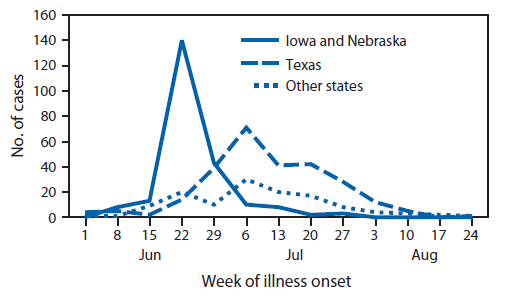Persons using assistive technology might not be able to fully access information in this file. For assistance, please send e-mail to: mmwrq@cdc.gov. Type 508 Accommodation and the title of the report in the subject line of e-mail.
Notes from the Field: Outbreaks of Cyclosporiasis — United States, June–August 2013
During June–August 2013, CDC, state and local public health officials, and the Food and Drug Administration (FDA) investigated an unusually large number of reports of cyclosporiasis (compared with annual reports to the National Notifiable Disease Surveillance System [e.g., 123 cases in 2012]), an intestinal infection caused by the parasite Cyclospora cayetanensis (1). By September 20, CDC had been notified of 643 cases from 25 states, primarily Texas (278 cases), Iowa (153), and Nebraska (86). Investigations in Iowa and Nebraska showed that restaurant-associated cases in these two states were linked to a salad mix that contained iceberg lettuce, romaine lettuce, red cabbage, and carrots (2). Most patients in Iowa and Nebraska became ill during June 15–29; cases reported during July and August were primarily from Texas (Figure).
CDC collaborated with state and local public health officials in Texas and the FDA to investigate a cluster of illnesses among patrons of a Mexican-style restaurant in Fort Bend County, Texas (restaurant A). A case of restaurant A–associated gastroenteritis was defined as gastrointestinal illness in a person who had eaten at restaurant A after June 1, 2013. Of 30 persons who ate at restaurant A, 22 had laboratory-confirmed C. cayetanensis infections, and eight had no laboratory confirmation. To identify the source or sources of the infections, a case-control study using 21 case-patients (15 laboratory-confirmed and six probable) with known meal dates and 65 controls matched by restaurant A meal date was conducted.
Case-patients and controls were asked about the meals they ate at restaurant A, using the menu. Ingredient-level analyses were conducted using meal consumption data and restaurant A recipes to identify four fresh produce ingredients with a statistically significant association with illness: fresh cilantro (matched odds ratio [mOR] = 19.8; 95% confidence interval [CI] = 4.0–>999), whole onions (mOR = 15.3; CI = 2.1–697.7), garlic (mOR = 10.7; CI = 1.5–475.4), and tomatoes (mOR = 5.5; CI = 1.1–54.1). Only fresh cilantro was consumed by all case-patients included in the study. In addition, of the four restaurant-produced salsas served at restaurant A, three containing fresh, uncooked cilantro were associated with illness: hot salsa (mOR 8.0; CI = 2.3–31.4), side salsa (mOR 5.7; CI = 1.6–23.7), and fire salsa (mOR 3.5, CI = 1.1–12.7). Case-patients also more commonly than controls reported eating salsa ranchera, which contained fresh cooked cilantro, but the association was not statistically significant: (mOR = 6.0; CI = 0.7–75.2).
Traceback information indicated that Puebla, Mexico, was a source of fresh cilantro served to ill persons at restaurant A. Lettuce served at restaurant A was neither sourced from the same producer implicated in the outbreak investigation in Iowa and Nebraska nor was it associated with illness. Additionally, restaurant A did not use red cabbage or carrots. Taken together, data from tracebacks and epidemiologic investigations in Texas, Iowa, and Nebraska indicate that more than one outbreak of cyclosporiasis occurred during summer 2013 in the United States, and that the food item associated with illness in Texas was different from that implicated in restaurant-associated cases in Iowa and Nebraska.
Reported by
M. desVignes-Kendrick, MD, Kaye Reynolds, MPH, Fort Bend County Health and Human Svcs; Teresa Lee, City of Rosenberg Health Dept; Linda Gaul, PhD, Kate Klein, Texas Dept of State Health Svcs. Kari Irvin, MS, Allison Wellman, MPH, Angela Hardin, MPH, Coordinated Outbreak Response and Evaluation Network, Office of Foods and Veterinary Medicine, Food and Drug Administration. Ian Williams, PhD, Div of Foodborne, Waterborne, and Environmental Diseases, National Center for Emerging and Zoonotic Infectious Diseases; Ryan Wiegand, MS, Julie Harris, PhD, Monica Parise, MD, Div of Parasitic Diseases and Malaria, Center for Global Health; Francisca Abanyie, MD, R. Reid Harvey, DVM, EIS officers, CDC. Contributing correspondent: R. Reid Harvey, rharvey@cdc.gov, 404-718-4689.
References
- Ortega Ynes R, Sanchez R. Update on Cyclospora cayetanensis, a food-borne and waterborne parasite. Clin Microbiol Rev 2010;23:218–34.
- Food and Drug Administration. FDA investigates multistate outbreak of cyclosporiasis. Silver Spring, MD: US Department of Health and Human Services, Food and Drug Administration; 2013. Available at http://www.fda.gov/food/recallsoutbreaksemergencies/outbreaks/ucm361637.htm.
FIGURE. Laboratory-confirmed cyclosporiasis cases by week of onset — United States, June 1–September 10, 2013

Alternate Text: The figure above shows laboratory-confirmed cyclosporiasis cases by week of onset in the United States during June 1-September 10, 2013. Most patients in Iowa and Nebraska became ill during June 15-June 29; cases reported during July and August were primarily from Texas.
Use of trade names and commercial sources is for identification only and does not imply endorsement by the U.S. Department of
Health and Human Services.
References to non-CDC sites on the Internet are
provided as a service to MMWR readers and do not constitute or imply
endorsement of these organizations or their programs by CDC or the U.S.
Department of Health and Human Services. CDC is not responsible for the content
of pages found at these sites. URL addresses listed in MMWR were current as of
the date of publication.
All MMWR HTML versions of articles are electronic conversions from typeset documents.
This conversion might result in character translation or format errors in the HTML version.
Users are referred to the electronic PDF version (http://www.cdc.gov/mmwr)
and/or the original MMWR paper copy for printable versions of official text, figures, and tables.
An original paper copy of this issue can be obtained from the Superintendent of Documents, U.S.
Government Printing Office (GPO), Washington, DC 20402-9371;
telephone: (202) 512-1800. Contact GPO for current prices.
**Questions or messages regarding errors in formatting should be addressed to
mmwrq@cdc.gov.
 ShareCompartir
ShareCompartir


